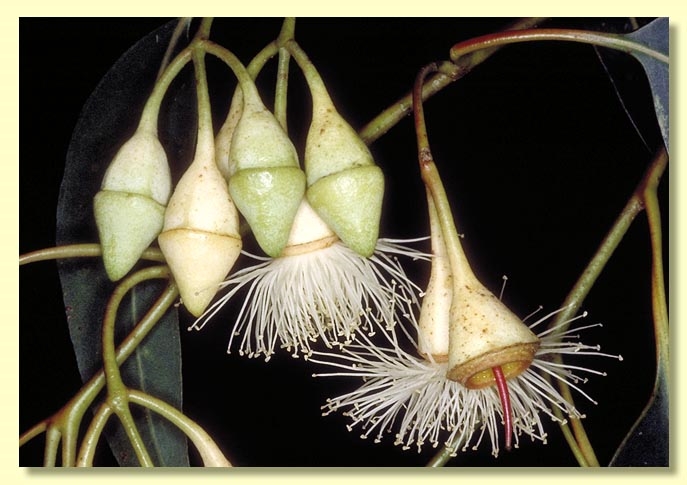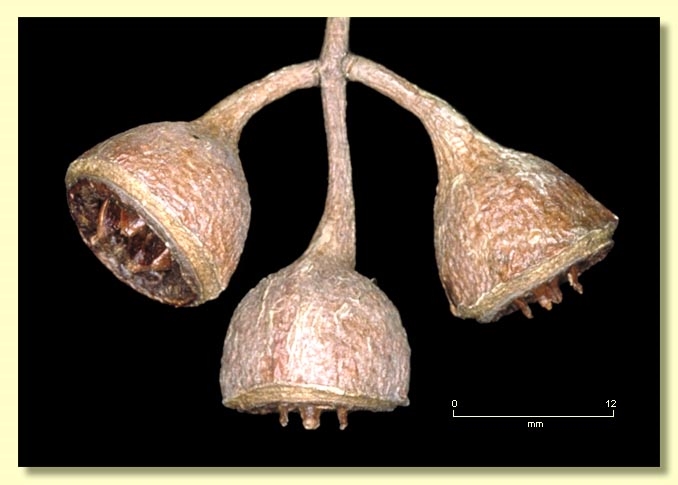Euclid - Online edition
Eucalyptus longifolia
Eucalyptus | Symphyomyrtus | Similares
Bark rough, fibrous, thin, box-type, irregularly cracked to tessellated or flaky, grey, persisting to smaller branches or branches < 8 cm diameter smooth.
Juvenile growth (coppice or field seedlings to 50 cm): stem square in cross-section, sometimes winged; juvenile leaves always petiolate, opposite for about 3–5 pairs, then alternate, ovate to broadly lanceolate, 6.5–20 cm long, 2–9 cm wide, base rounded or tapering to petiole, slightly discolorous, dull, green to grey-green.
Adult leaves alternate, petiole 1.5–3.2 cm long; blade falcate to lanceolate, 9–25 cm long, 0.8–3.5 cm wide, base tapering to petiole, concolorous, dull, green to grey-green, side-veins greater than 45° to midrib, moderately reticulate, intramarginal vein parallel to and just within margin, oil glands island.
Inflorescence axillary unbranched, peduncles usually pendulous, 1–3.4 cm long, buds 3, pedicellate (pedicels 0.7–1.7 cm long). Mature buds ovoid to diamond-shaped (1.6–2.7 cm long, 0.75–1.3 cm wide), green or creamy, hypanthium slightly angled longitudinally, scar present, operculum usually conical, stamens inflexed, anthers cuboid to oblong, versatile, dorsifixed, dehiscing by longitudinal slits (non-confluent), style long, stigma blunt or tapered, locules 3 or 4, the placentae each with 8 or more vertical ovule rows or the vertical rows indistinct. Flowers white.
Fruit pedicellate (pedicels 0.5–2 cm long), cup-shaped to cylindrical or hemispherical, with a thick rim, 0.8–1.5 cm long, 0.9–1.6 cm wide, disc descending, valves 3 or 4, near rim level or enclosed.
Seeds yellow to brown or almost black, 1–2 mm long, pyramidal or obliquely pyramidal, dorsal surface pitted or smooth, margin toothed, hilum terminal.
Cultivated seedlings (measured at ca node 10): cotyledons bilobed; stems square in cross-section and winged; leaves always petiolate, opposite for 3–5 pairs then becoming alternate, ovate, 7–12.5 cm long, 2–6 cm wide, base rounded to tapering, margin entire, apex pointed, concolorous, dull, green.
Flowering has been recorded in March, April, May and June.
A medium-sized tree of coastal New South Wales from near Newcastle south almost to the border with Victoria. E. longifolia could not be confused with any other species in the vicinity because of the thin rough bark and conspicuous, large, pendulous cream-coloured buds and fruit in threes. The buds and fruit may superficially resemble E. tricarpa which is, however, an ironbark with buds that lack an operculum scar (present in E. longifolia).
Eucalyptus longifolia is a solitary species in Eucalyptus subgenus Symphyomyrtus section Similares because cotyledons are bilobed, leaves are concolorous, inflorescences are pendulous with moderately large buds in threes, the buds have two opercula, inflexed stamens and ovules in eight or more rows, fruit have exserted valves, and seeds are more or less pyramidal with toothed margins.













